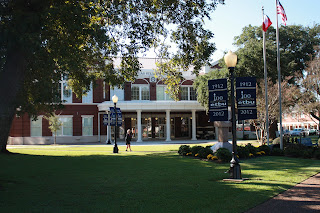"Lone Star Historian" is a blog about the travels and activities of the State Historian of Texas. Bill O'Neal was appointed to a two-year term by Gov. Rick Perry on August 22, 2012, at an impressive ceremony in the State Capitol. Bill is headquartered at Panola College (www.panola.edu) in Carthage, where he has taught since 1970. For more than 20 years Bill conducted the state's first Traveling Texas History class, a three-hour credit course which featured a 2,100-mile itinerary. In 2000 he was awarded a Piper Professorship, and in 2012 he received the Lifetime Achievement Award from the Wild West Historical Association. Bill has published almost 40 books, half about Texas history subjects, and in 2007 he was named Best Living Non-Fiction Writer by True West Magazine.
After accepting an invitation to participate in the Amarillo Public Library Book Festival during the last weekend in October, I allowed myself a couple of extra days to visit historical sites and museums in northwest Texas and the Panhandle. At the top of my list was a return to the former "Cowboy Capital of the Panhandle," old Tascosa.
 |
| Replicas of the tombstones of the three LS cowboys killed in "The Big Fight" L to R: Ed King, Frank Valley, Fred Chilton |
My first stop was at Tascosa's Boot Hill. There were 10 fatal shootouts in Tascosa during its 1880s heyday, including "The Big Fight," a Saturday night saloon battle on March 21, 1886. Three LS cowboys were killed, along with a fatally curious bystander. These four men were buried on Boot Hill, alongside other gunfight victims, as well as citizens who died of natural causes. The LS Ranch provided gravestones for their three riders, but through the years souvenir hunters chipped away so steadily that in time nothing was left. White metal crosses with black lettering now mark the gravesites atop the hill, and replicas of the three LS tombstones are in place just inside the cemetery gate.
 | ||
| Tascosa's frame school was built at the north end of town. |
The town stood below Boot Hill about half a mile to the northeast and just north of the Canadian River. Great ranches developed in the vicinity, including the LS, the LIT, the Frying Pan, and the three-million-acre XIT. The first Anglo-American structure in the upper Panhandle was a one-room adobe erected by blacksmith Henry Kimball. Soon an adobe general store was built nearby. Assorted other businesses dedicated to serving the ranches and their cowboys were established along a two-block Main Street that ran east and west. The Exchange Hotel was the town's only hostelry, the Tascosa Pioneer became the only newspaper, and the Equity Bar was Tascosa's first - and most famous - saloon. A two-story stone courthouse was built in 1884, after Tascosa became the seat of newly organized Oldham County. The population reached 600, with additional numbers of cowboys and ranchers who regularly rode in from the surrounding countryside to patronize the stores and saloons.
A cluster of dives a quarter of a mile east of Main Street was dubbed Hogtown, partially because of the presence of such less than glamorous "sporting women" as Homely Ann, Gizzard Lip, Rowdy Kate, Box Car Jane, Panhandle Nan, Slippery Sue, Canadian Lily, and Frog Lip Sadie. In 1878, Billy the Kid and four other fugitives from New Mexico's Lincoln County War arrived with 150 stolen horses, enjoying Tascosa's bawdy pleasures for several weeks. During the 1880s there was so much rustling in the area that Pat Garrett was hired to lead a band of "Home Rangers." The West's most famous cowboy strike headquartered at Tascosa in 1883.
Heavy rains flooded the Canadian River in 1893. The river's wagon bridge was swept away, and 17 buildings were destroyed when their flat roofs caved in. Soon, merely a handful of the remaining structures were occupied, and Tascosa slumped into permanent decline. In 1915, the new town of Vega wrested away the seat of county government.
But 1939 marked an unexpected rebirth for the one-time cattle town. Philanthropist Cal Farley organized a Boys Ranch for unfortunate youths, and from a modest beginning the institution now boasts a complex of modern buildings atop the former townsite. A Girls Ranch has been added, and the population now exceeds that of Tascosa during its frontier heyday. All that remains from the 19th century are the courthouse, the one-room frame school, and Boot Hill, last home of the pioneers who lived, fought, and died in the Cowboy Capital of the Panhandle.
For more information:
www.calfarley.org
Heavy rains flooded the Canadian River in 1893. The river's wagon bridge was swept away, and 17 buildings were destroyed when their flat roofs caved in. Soon, merely a handful of the remaining structures were occupied, and Tascosa slumped into permanent decline. In 1915, the new town of Vega wrested away the seat of county government.
But 1939 marked an unexpected rebirth for the one-time cattle town. Philanthropist Cal Farley organized a Boys Ranch for unfortunate youths, and from a modest beginning the institution now boasts a complex of modern buildings atop the former townsite. A Girls Ranch has been added, and the population now exceeds that of Tascosa during its frontier heyday. All that remains from the 19th century are the courthouse, the one-room frame school, and Boot Hill, last home of the pioneers who lived, fought, and died in the Cowboy Capital of the Panhandle.
For more information:
www.calfarley.org











































